Austin’s Dirtiest Job: Cleaning Up ‘Dirty Sixth’ in the Dark of the Night
By Lucy White
Photography By Dayana Lopez
Reporting Texas
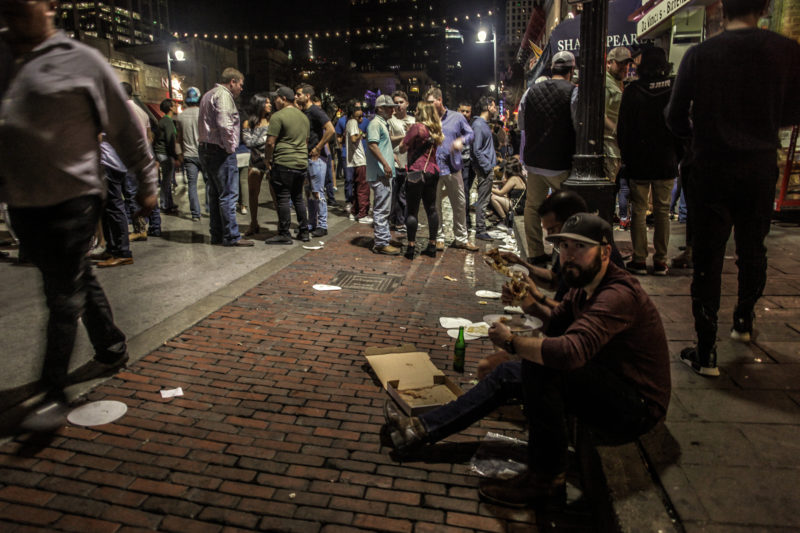
Nightlife crowds jam into Sixth Street bars and wait outside of Roppolo’s Pizza for a slice. The tourists and locals who fill the downtown bar district leave behind a mountain of refuse.
The grittiest stretch of Sixth Street at 2:30 on a Saturday morning lives up to its nickname, “Dirty Sixth.” When the bars close, people roam to find street food or a place to relieve themselves. In front of Roppolo’s Pizza, plastic cups spill out of trash cans and paper plates litter the sidewalk.
The unsettling sound of a woman’s distant scream pierces the air.
After the last partiers finally stumble into Ubers and taxis, Austin’s downtown becomes quiet and Sixth Street is all but deserted. Then, the flashing lights of a white garbage truck emerge, signaling the start of a transformation.
Shift supervisor Michael Womack starts his workday communicating with his Austin Resource Recovery (ARR) team over a truck intercom as everyone assembles. Womack supports a team that works overnight to clean up downtown. They spend half their time in the few hours before dawn on the area surrounding Dirty Sixth, as it’s sometimes called — the seven blocks between Congress Avenue and Interstate 35.
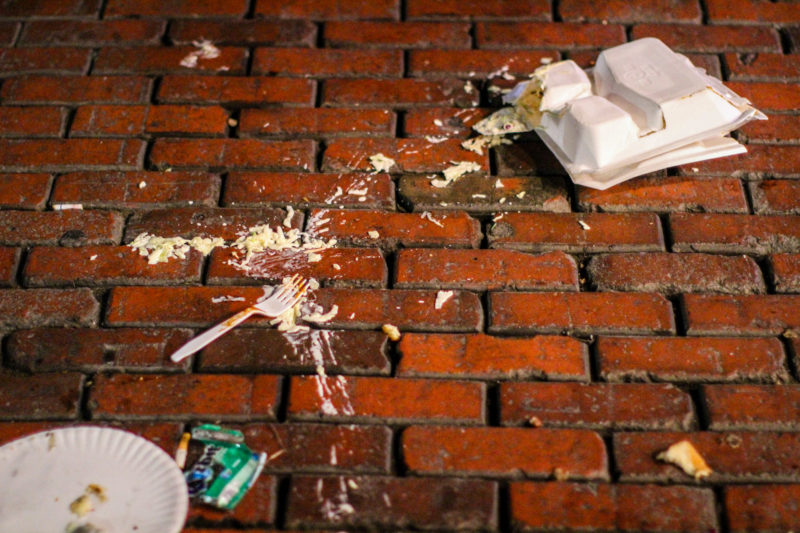
By the time the Austin Resource Recovery team arrives, the trash cans already are are overflowing. Part of the team focuses on removing the trash from the sidewalks.
His team is one component of the city’s extensive maintenance strategy for East Sixth Street, one of the city’s most popular bar and tourist districts. ARR teams clean up the street every night. Crews from the city’s Public Works Department power-wash the sidewalks about once month — twice as often as they do in other parts of downtown.
When sanitation workers finish, the litter, vomit and broken glass are gone. They scrub blackened sandstone sidewalks back to their original pink. By the time hotel guests at The Driskill, at Sixth and Brazos, wake up, the street will be spotless, or as clean as Dirty Sixth can look.
“I get kind of antsy in the truck, so a lot of times on busy days … I’ll get out and help them,” says Womack. He points to one of the four “blowers,” team members who use gasoline-powered backpack blowers to move trash from the sidewalks to the streets.
“Sweepers” come next, driving the street-sweeper trucks that collect debris. Meanwhile, two garbage trucks circulate through downtown at a fast clip to empty 760 trash cans. In the Sixth Street area, the job is messy.
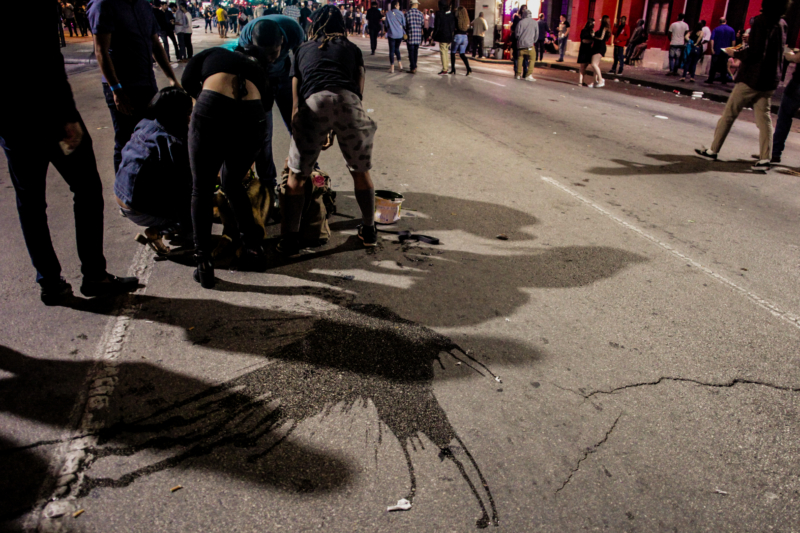
A crowd gathers around a German Shepherd and its owner, surrounded by drinks spilled on the ground. “People behave differently when they’re in an area that’s maintained. That’s part of the problem,” says Bill Brice, an executive of the Downtown Austin Alliance, which also helps keep the area clean.
“You got people throwing up in the trash cans, you got people peeing in the trash cans. And you just have to really pay attention to where you’re putting your hands,” says Womack.
As he circulates around Sixth Street, Womack pulls into an alley to follow the “flusher,” a vehicle that dumps water on alleys and streets. The flushing “helps with the stench,” according to Amy Slagle, assistant division manager for ARR.
Within a few minutes of following behind the flushing work in his truck, Womack brakes twice while his flusher truck operator pauses to avoid disturbing people sleeping in doorways or next to Dumpsters. They try to flush all of Dirty Sixth before 5:30.
But the flushing can only remove so much. Every night, Womack passes a crew of Public Works employees who power-wash downtown sidewalks.
Sixth Street sidewalks are sandstone, unlike the granite used on Congress Avenue. During the day, the sun bakes dirt and grime into the porous stone. Depending on the night, it can take Public Works employees up to five hours to clean one side of a single block.
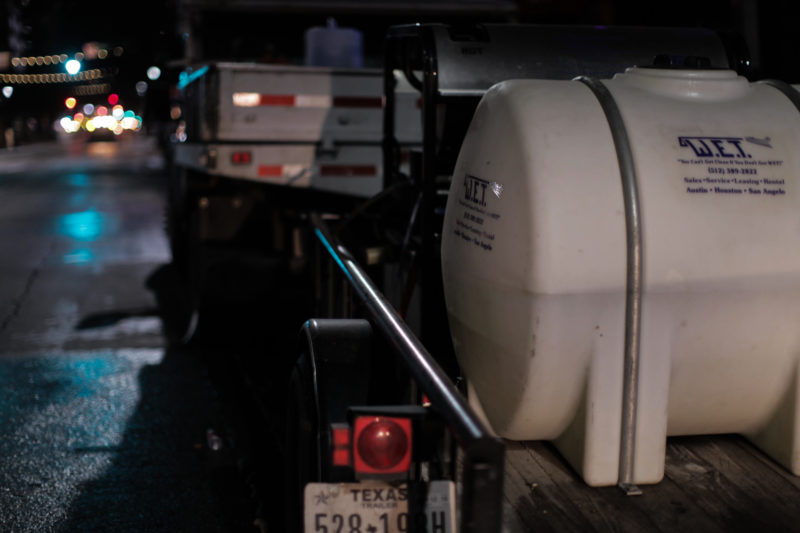
Public Works employees use pressure washers to wash away as much of the grime and filth as possible.
To start, they clear trash, apply biodegradable soap on the sidewalk and place a large vacuum hose into the storm drains to prevent some runoff from getting into the Waller Creek watershed. Cleaning teams then make multiple passes back and forth over the same portion of sidewalk with power washing machines.
Power washers must wear goggles and protect their feet with waterproof boots. Full hazmat suits and masks are optional because they can be uncomfortably hot, especially during the summer. Workers make a trade-off, though: more protection prevents them from getting splattered.
Blowers work to avoid the same problem. “You also have to look out for the stuff on the ground. People use the bathroom on the ground, and you don’t want to blow that on you,” says Womack.
Once, Womack had to return to headquarters during South by Southwest after accidentally directing his blower onto a puddle of vomit. “I didn’t see it, but I smelled it,” he remembers. He threw away his clothes and now wears only long sleeves, no matter the weather.
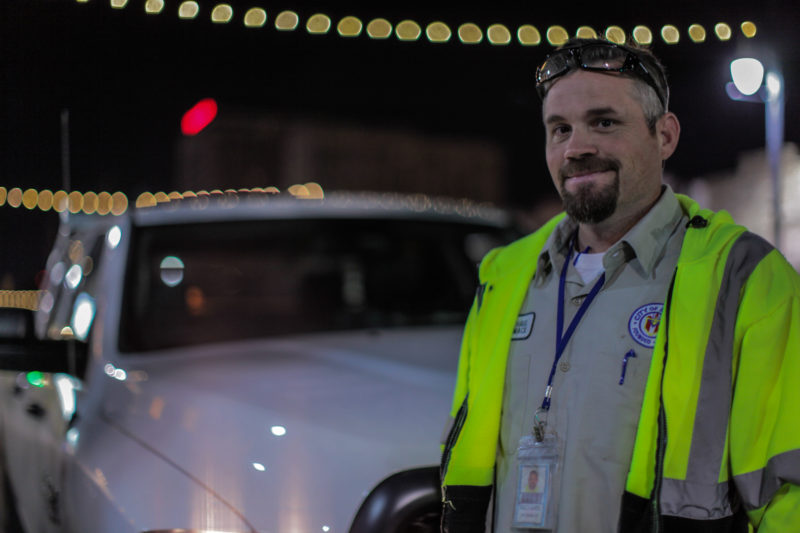
Michael Womack is in charge of a team of workers who spend the early morning hours cleaning up the streets for the next morning.
Downtown can look empty in the middle of the night, and Womack says he rarely sees police officers patrolling on foot. That often leaves sanitation workers to report danger. “We’re worried about staying safe. If somebody is passed out in the alley drunk, I’ll call that in,” he says.
Workers operate in teams for protection. Sweepers drive behind blowers to collect trash, but also to keep an eye out. Both blowers and power washers operate loud equipment and must focus on the ground while they work, leaving them exposed.
“We’ve had people drive by, take mirrors off sweepers. We’ve had people reach behind a blower and grab them, spit at us, throw stuff at you, food, cans, whatever,” Womack says. “You name it, you name it! No, for real, you name it.”
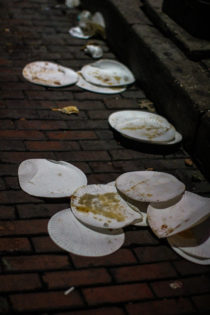
Paper plates from Roppolo’s Pizza fill the streets. One worker said that during South b Southwest, so many plates will be on the street that it will “look like it snowed.”
Jesse Olivarez works for Public Works and says the experience of cleaning Sixth Street at night reminds him of how it felt when he worked in a maximum security prison. Recently, he watched a man walk down the street holding out a knife; he stopped power washing until the man left. “You just keep your eyes out and don’t turn your back. You don’t know. People are unstable. Who can predict what’s going to set them off?” Olivarez says.
Olivarez is often working exhausted — he finds it hard to sleep in the middle of the day. “I try to take a hot shower, go to bed, but then you’re worried if the phone rings, that interrupts your sleep and messes up your pattern,” he says. Each Sunday, he weighs his desire to attend church with his need to rest.
Charles Felipa supervises the overnight Public Works team and averages about four hours of sleep a day. He has also written a column for the department’s magazine, Street Talk, called “Tales from Sixth.” His stories include the time he recovered a stolen wallet by pursuing a thief on the run and the time a drunken woman got into their truck, thinking it was a taxi.
When Felipa gets home, he sleeps for four hours and then gets up to pick up his five children from the bus stop after school, and then read to them before bed. The crews work an unusual schedule. On his last day of the workweek, he often stays up for 26 hours straight or longer so he can have two days on the same schedule as his family.
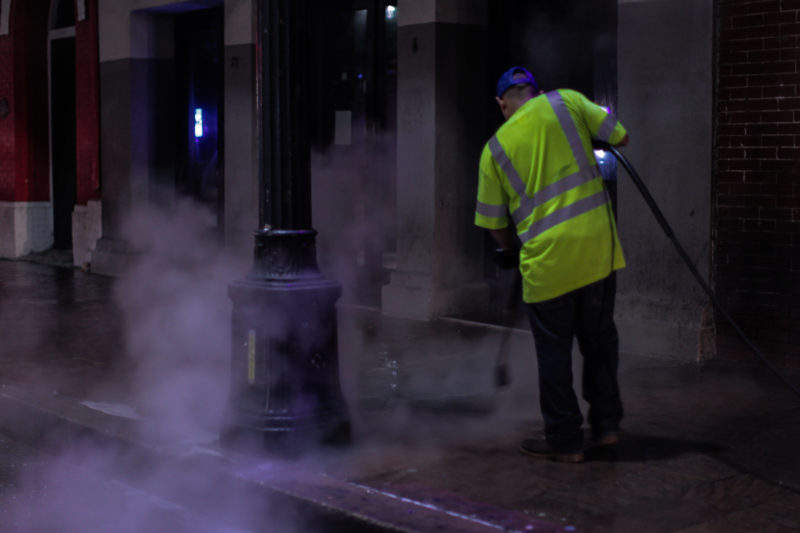
A city worker uses a pressure washer to get rid of spilled drinks and other material that blackens the sandstone sidewalks.
Many overnight sanitation employees have been with the city for over a decade, according to Slagle. She points to the benefits of the unique schedule: a three-day weekend, spending time with children or running errands. “Some really enjoy it,” she says.
Felipa has worked overnight for seven years, but says it is not for everyone. He estimates that he has worked with 50 different people, as coworkers come and go. “For Street and Bridge, that’s the epitome of a revolving door,” he says.
Public Works employees receive an additional 75 cents an hour for overnight work. Olivarez says that at other jobs, he always has tried to work night shifts for the additional money. He says he never received less than $1 pay differential until he worked for the city.
Womack has been with the city for more than 14 years and wishes he had started directly out of high school. For him, the key benefit is security that can be hard to find anymore in other industries. He says many jobs offer a 401(k) plan, but that there are “not many places you can go and receive a pension, I mean a real pension.”
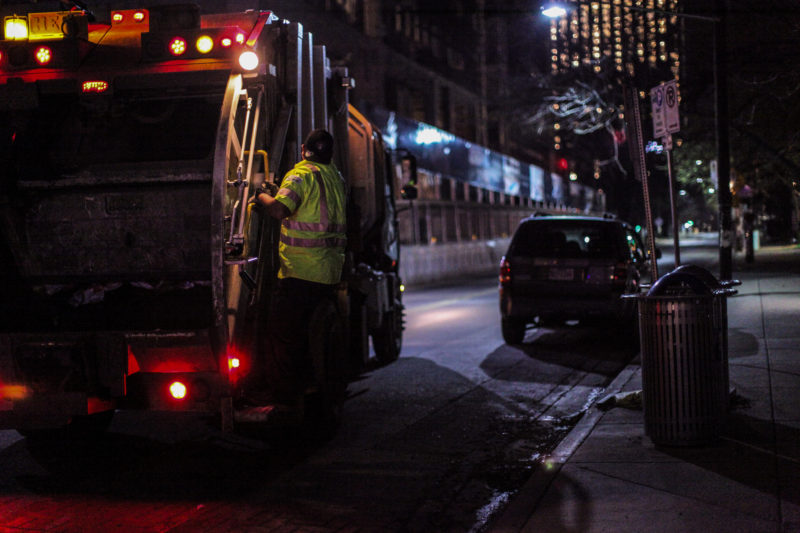
Trash trucks drive through downtown emptying all 760 public trash cans.
The city of Austin and the Downtown Austin Alliance work to keep Sixth Street as clean as possible in part to encourage better behavior.
“People behave differently when they’re in an area that’s maintained,” says Bill Brice, vice president of operations for the alliance, which represents downtown property owners. The group advocates for a vision of downtown that would diversify the mix of businesses along Sixth Street, which now is mostly bars.
Brice said the challenge is to preserve the character of the district while also introducing a new street design that could improve safety and cleanliness.
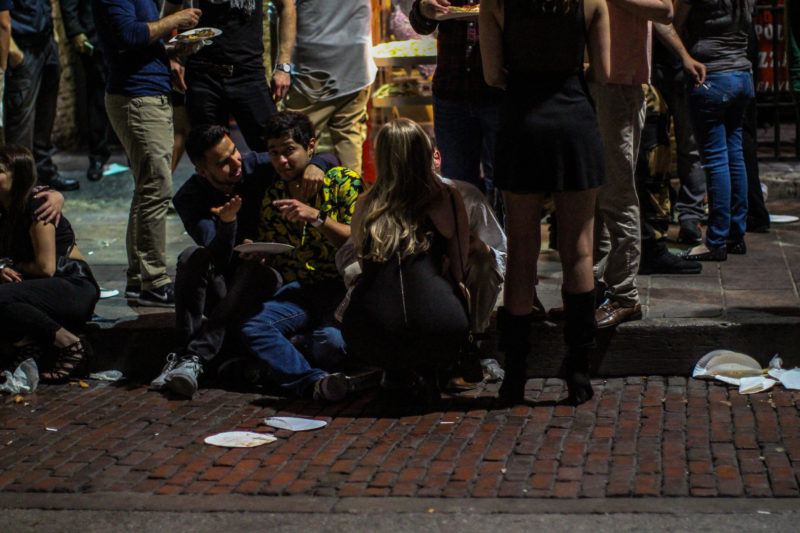
Outside Roppolo’s Pizza before the bars close for the night.
For most Sixth Street bars, the peak time to bring in revenue is on weekend nights, when the crowds are the biggest. The city also closes East Sixth to traffic, creating a street-party atmosphere that can get raucous.

The customers leave half-eaten pizza and paper plates outside the popular pizza spot.
In 2016, a man shot and killed a woman after 2 a.m. outside Voodoo Donut.
DAA hires “ambassadors” who roam downtown during the day to help clean up the district, such as picking up refuse. Still, Sixth Street becomes filthy again every night. The city cleaning team works 364 days a year.
Sanitation work is the fifth most dangerous job in the U.S., according to the Bureau of Labor Statistics. Austin workers encounter equipment hazards as well as the particular challenges of overnight shift work in a part of the city known for rowdiness.
About 4 a.m., Womack gets a report from his team members over the truck intercom: there’s a dog fight in an alley. There are periods when he calls the police every night, and then weeks will pass without incident. He does not know why. “Sometimes when it’s a full moon? I swear to you, things run on a different channel,” he says.
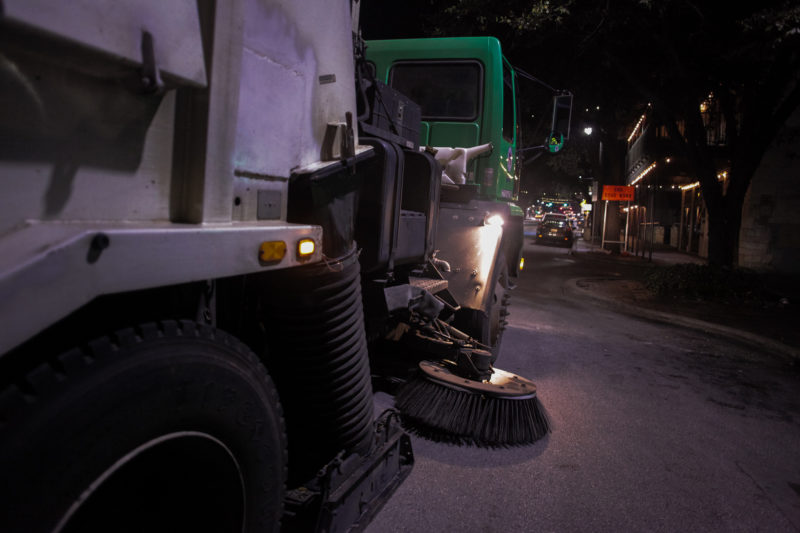
Street sweepers passing through Sixth Street, sweeping up the trash that city workers armed with gas-powered blowers blast off the sidewalks.
Certain festivals create more work. Felipa told a new crew member in February, “Wait until South by Southwest — you won’t see the sidewalks because it’ll be covered in pizza plates, and it’ll look like it snowed.” Womack also thinks football season produces more trash.
Womack grew up in Austin and enjoys seeing the city evolve and grow. He says downtown used to feel empty in the early morning. But in recent years, his team overlaps with more people — construction workers arriving at 4:30.
Part of Austin’s identity is wrapped up in the allure of destinations like Sixth Street. But tourism and hotels also benefit from a clean downtown. Maintaining current conditions depends on the nightly cleaning efforts. “These guys do an amazing job. To see downtown at 2:30 and come back at 6:30, it’s spotless,” says Slagle.
An hour before dawn, Womack circles back to Roppolo’s Pizza. No trash remains. Smiling, he says, “See look how clean that looks? Isn’t that something else?”
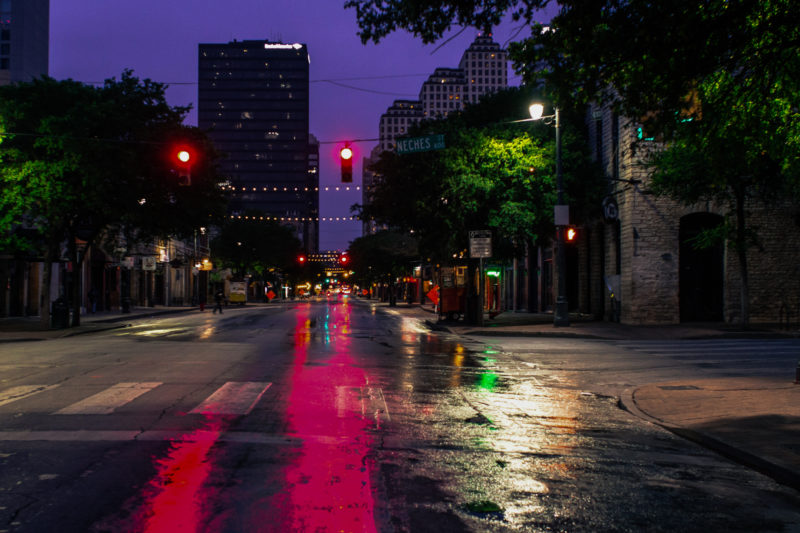
By 5:30 a.m., the street is clean.